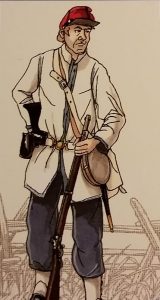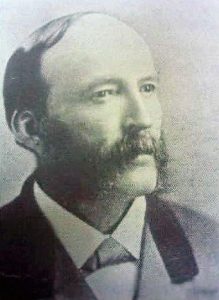Shiloh: Preston Pond’s Charge at Tilghman Branch
Among the largest brigades to fight at Shiloh was Colonel Preston Pond’s outfit, mostly made up of Louisiana troops. It numbered around 2,600 men. 1,400 of these were in two regiments, the 38th Tennessee and the Crescent Regiment, a militia outfit made up of wealthy men from New Orleans, mostly Anglo-Americans. By contrast there was the Orleans Guard Battalion, 300 men drawn from the Creole elite of the city. The 16th and 18th Louisiana were mostly rural outfits, with the 18th Louisiana being mostly Acadian. Captain William H. Ketchum’s Alabama State Artillery was attached with six cannons.

Pond was born in New Hampshire but raised in the Florida parishes of Louisiana. He was a lawyer and farmer, and appears to have preferred hiring Irish help over purchasing slaves, although he was affiliated with the anti-immigrant Nativist Party. He was also a successful politician and a militia officer who took his task seriously. Pond raised and commanded the 16th Louisiana. He was a martinet, which made him unpopular. Comically, when he died in 1864 his headstone read that he was “loved by all.”
For most of April 6, the opening day of Shiloh, Pond’s brigade marched and fought but suffered relatively light losses . By 4:00 p.m., they were the only Rebel infantry on the left flank, although the brigade numbered only 1,000 men. The 38th Tennessee, Crescent Regiment, and two cannons from the Alabama State Artillery were guarding Owl Creek Bridge and were drawn into the fighting at the Hornet’s Nest.
At 4:30, Patrick Cleburne attacked into Cavalry field with four regiments and managed to scattered the Union forces there before being stopped by the 81st Ohio. At the same time, P.G.T. Beauregard sent Lieutenant Colonel Samuel Ferguson to Jones Field to take over Pond’s brigade. Ferguson was a recent West Point graduate and fire-eater. He was young, ambitious, and something of a trouble-maker. He likely embezzled money from the Mississippi Levee Board after the war. On April 6 he was hungry for glory.
Ferguson reported to Hardee, who ordered him to capture Battery D of the 1st Illinois Artillery, which was shelling Hardee’s men from Mulberry Field. The Alabama State Artillery and the 5th Company of the Washington Artillery (Louisiana) would provide support. Ferguson found Pond’s brigade and learned that Pond was very much in command. Pond had made a personal reconnaissance of John McClernand’s division, which was posted near Tilghman Branch. This absence might have caused Beauregard to think Pond was not in command and thus the reason for Ferguson’s assignment.

Ferguson informed Pond of Hardee’s orders Pond informed Ferguson that the attack would be foolish. He sent him back to inform Hardee, who merely confirmed the order. Pond said “Very well, sir. I will obey the order, but do so under protest.” Ferguson later asserted that he led the attack. This is unlikely, but it is very likely he took part in the attack.
Because of the dense terrain, Pond’s men did not come under long range fire. However, Pond attacked en echelon, which allowed the Union to pour fire on the regiments individually. Colonel Alfred Mouton, commander of the 18th Louisiana, protested the order stating “You will make me sacrifice all my men to no avail.” Mouton dutifully led his men up the ravine that divided Cavalry and Mulberry Fields. From there they formed up in Mulberry Field. At fifty yards the artillery opened up. Mouton’s horse was shot from under him and the regiment fled for the rear, losing 207 men.

Pond pressed on. He ordered “Orleans Guard, charge!” and the men lunged forward. The battalion moved through the shattered remains of the 18th Louisiana, with Private Edmond Livaudais recalling “it was truly horrendous” and men were “bathed in their blood” and asked “for water and help.”
The Orleans Guard made a superb effort. The flag, which was held up but the flagstaff from Fort Sumter, saw four color bearers fall. The fifth, Captain Alfred Roman, saved it from capture. Major Leon Querouze, the battalion commander, went down with a wound. The battalion lost ninety men out of 300. The 16th Louisiana, which was to the rear, did not press its advance. Losses were light although Major Daniel Gober had his horse shot from under him and led the men on foot.
Pond lost over 300 men in only a few minutes. Although Pond made good use of terrain, his attack formation was poorly chosen and he hit a particularly strong part of McClernand’s line. Pond was also accused of not being on hand to direct his men or rally them. It was not an accusation of cowardice, but of mismanagement which likely played a part in Pond not being promoted nor reelected to command the 16th Louisiana. Roman, who later served on Beauregard’s staff and helped him write his autobiography, was particularly critical of Pond, and no doubt made his feelings known to his friend.

The musket era provided ubiquitous evidence of failed frontal attacks on strong positions. The most horrendous was Assietta, one of the last battles fought in the War of the Austrian Succession. At that battle, a French army attacked an out-numbered but well positioned Sardinian army and lost 6,400 men, while inflicting only 300 losses at most. Pond’s charge was in numerous, if melancholy company.
The reasons for such failures were often poor communication and impetuousness. Hardee had not scouted the ground, and with the fighting at the Hornet’s Nest intensifying, he likely wanted to help. In the heat of battle, frontal attacks were made on positions far too strong to be carried with any consistently. The musket made defense much easier, and few commanders of the era were able to consistently win decisive victories. The exceptions were Marlborough, Napoleon, and Frederick II (commonly called the Great). What each had in common was a first rate cavalry force capable of powerful charges and pursuit. Civil War armies lacked these, and it was a major reason the battles were indecisive.

Yet, there is another reason these attacks were made. Sometimes they worked. Shiloh had already seen A. P. Stewart make a bold charge across Review Field that pierced the Union line. Pond’s attack failed, but it did frazzle McClernand’s line. William Camm of the 14th Illinois said “In an instant the air seemed full of bullets.” Camm and his 14th Illinois fled amid men shouting “Run, Colonel, run” One soldier fell in Camm’s arms and said “Mother” right before he died. A Rebel attack with more than half of a brigade may very well have shattered McClernand’s men, who did stagger back towards Chambers Field. Hardee wanted the cannons silenced, and Pond did just that, with two pieces being abandoned in the Union withdrawal.
Regardless, attacks such as Pond’s had a low success rate, even if on occasion they achieved spectacular results. Those rare successes were arguably seductive. Ulysses Grant, who from 1862 to 1863 had mostly avoided frontal assaults on strong positions, was moved by the Army of the Cumberland’s dash up Missionary Ridge. It might explain his poor tactical choices in Virginia in 1864. Braxton Bragg, who had ordered Stewart to attack at Review Field, would himself order disjointed and piecemeal assaults on the Hornet’s Nest, and later at Stones River and Chickamauga. If the Civil War had ended in the summer of 1862, Pond’s isolated attack might be better known among buffs and historians. Sadly, poor assault tactics were all too common in the American Civil War.
“Florida parishes of Louisiana”? I’m curious to learn what this means.
On the subject of Pond’s brigade: A friend of mine had an ancestor in McDowell’s Federal brigade (which I believe was attacked by Pond in the early going), so we had to locate their line when we visited Shiloh. Well, it is outside the Park, and consists of a line of markers in the front yards of a modest set of homes!
The panhandle of Spanish Florida originally extended all the way to the Mississippi River. So the parishes of Louisiana that were part of Spanish Florida (Spanish West Florida) would be the Florida parishes. There was also the Republic of West Florida, which was a briefly (several months) independently declared state. The United States annexed it in 1810.
Jackson, LA is my hometown. My parents still live in the country near there. The Republic of West Florida flag is one of the flags the locals like to fly. Preston Pond would have known it. He’s buried there.
And supposedly the Texans go their lone star idea from the Republic of West Florida flag. Lots of Louisianians (or people who might have settled/homesteaded briefly in Louisiana) migrated to Texas.
The Bonnie Blue Flag.
Which of McDowell’s regiments was it? I know the western most in camp was the 6th Iowa with the 46th Ohio being nearby.
I’m pretty sure it was the 6th Iowa.
So yeah, Preston Pond failed re-election in the spring of 1862 and so he resigned/quit the Confederate army.
Interestingly, he turns up later in the OR (if I recall correctly), before he dies in 1864, complaining of Confederate guerillas in the Felicianas area harassing/thieving on the locals. Jackson changed hands a couple of times maybe after the Port Hudson campaign. It was within the Federal’s foraging area during the siege of Port Hudson, but some independant/detached Confederate cavalry units moved in and out of the area from time to time.
The famous diarist Sarah Morgan lived about equidistant from Port Hudson to Jackson.
Independent
Thanks for your comments Lyle. Good to see a fellow Louisiana native on here.